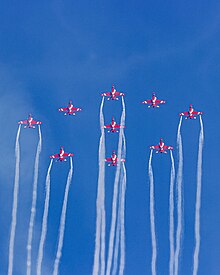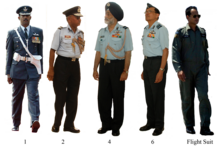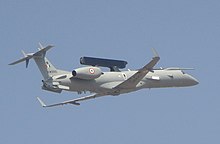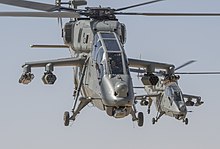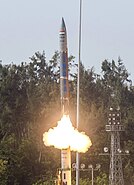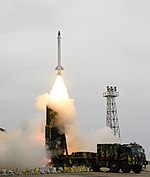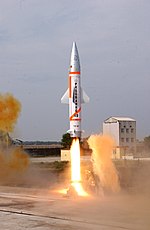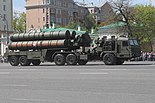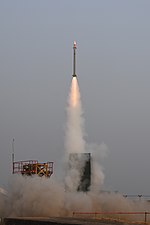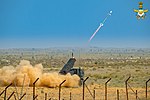Air Force Of India
140,000 reserve personnel
Approx 1926+ aircraft
transl. "Touch the Sky with Glory" (Taken from Bhagavad Gita)
- Quick: Dēśa Pukārē Jaba Saba Kō
(When the Country Calls Everyone) - Slow: Vāyu Sēnā Niśāna
(The Air Force Emblem)
- World War II
- Indo-Pakistani War of 1947
- Congo Crisis
- Operation Vijay
- Indo-Pakistani War of 1965
- Operation Cactus-Lilly
- Battle of Boyra
- Bangladesh Liberation War
- Operation Meghdoot
- Operation Poomalai
- Operation Pawan
- Operation Cactus
- Kargil War
- Pakistan Navy Atlantic shootdown
- 2019 Balakot airstrike
- India–Pakistan border skirmishes (2019)
- 2020–2021 China–India skirmishes
- Operation Ganga
commanders




warfare
The Indian Air Force (IAF) is the air arm of the Indian Armed Forces. Its primary mission is to secure Indian airspace and to conduct aerial warfare during armed conflicts. It was officially established on 8 October 1932 as an auxiliary air force of the British Empire which honoured India's aviation service during World War II with the prefix Royal. After India gained independence from United Kingdom in 1947, the name Royal Indian Air Force was kept and served in the name of the Dominion of India. With the transition to a republic in 1950, the prefix Royal was removed.
Since 1950, the IAF has been involved in four wars with neighbouring Pakistan. Other major operations undertaken by the IAF include Operation Vijay, Operation Meghdoot, Operation Cactus and Operation Poomalai. The IAF's mission expands beyond engagement with hostile forces, with the IAF participating in United Nations peacekeeping missions.
The President of India holds the rank of Supreme Commander of the IAF. As of 1 July 2017, 170,576 personnel are in service with the Indian Air Force. The Chief of the Air Staff, an air chief marshal, is a four-star officer and is responsible for the bulk of operational command of the Air Force. There is never more than one serving ACM at any given time in the IAF. The rank of Marshal of the Air Force has been conferred by the President of India on one occasion in history, to Arjan Singh. On 26 January 2002, Singh became the first and so far, only five-star rank officer of the IAF.
Mission
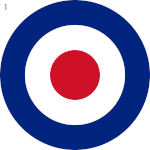
- 1933–1942
- 1942–1945
- 1947–1950
- 1950 – present
The IAF's mission is defined by the Armed Forces Act of 1947, the Constitution of India, and the Air Force Act of 1950. It decrees that in the aerial battlespace:
Defence of India and every part there of including preparation for defence and all such acts as may be conducive in times of war to its prosecution and after its termination to effective demobilisation.
- The Primary objective of IAF is to defend the nation and its airspace against Air threats in coordination with Army and Navy.
- The secondary purpose is to assist civil power during natural calamities and internal disturbances.
- The IAF provides close air support to the Indian Army troops in the battlefield and also provides strategic and tactical airlift capabilities.
- IAF also provides strategic air lift or secondary Airlift for the Indian Army.
- The IAF also operates the Integrated Space Cell together with the other two branches of the Indian Armed Forces, the Department of Space and the Indian Space Research Organization (ISRO).
- Rescue of civilians during natural disasters
- Evacuation of Indian nationals from foreign countries in case of instability or other problems
In practice, this is taken as a directive meaning the IAF bears the responsibility of safeguarding Indian airspace and thus furthering national interests in conjunction with the other branches of the armed forces. The IAF provides close air support to the Indian Army troops on the battlefield as well as strategic and tactical airlift capabilities. The Integrated Space Cell is operated by the Indian Armed Forces, the civilian Department of Space, and the Indian Space Research Organisation. By uniting the civilian run space exploration organisations and the military faculty under a single Integrated Space Cell the military is able to efficiently benefit from innovation in the civilian sector of space exploration, and the civilian departments benefit as well.
The Indian Air Force, with highly trained crews, pilots, and access to modern military assets provides India with the capacity to provide rapid response evacuation, search-and-rescue (SAR) operations, and delivery of relief supplies to affected areas via cargo aircraft. The IAF provided extensive assistance to relief operations during natural calamities such as the Gujarat cyclone in 1998, the tsunami in 2004, and North India floods in 2013. The IAF has also undertaken relief missions such as Operation Rainbow in Sri Lanka.
History
Formation and early pilots

The Indian Air Force was established on 8 October 1932 in British India as an auxiliary air force of the Royal Air Force. The enactment of the Indian Air Force Act 1932 stipulated out their auxiliary status and enforced the adoption of the Royal Air Force uniforms, badges, brevets and insignia. On 1 April 1933, the IAF commissioned its first squadron, No.1 Squadron, with four Westland Wapiti biplanes and five Indian pilots. The Indian pilots were led by British RAF Commanding officer Flight Lieutenant (later Air Vice Marshal) Cecil Bouchier.
World War II (1939–1945)
During World War II, the IAF played an instrumental role in halting the advance of the Japanese army in Burma, where the first IAF air strike was executed. The target for this first mission was the Japanese military base in Arakan, after which IAF strike missions continued against the Japanese airbases at Mae Hong Son, Chiang Mai and Chiang Rai in northern Thailand.
The IAF was mainly involved in strike, close air support, aerial reconnaissance, bomber escort and pathfinding missions for RAF and USAAF heavy bombers. RAF and IAF pilots would train by flying with their non-native air wings to gain combat experience and communication proficiency. Besides operations in the Burma Theatre IAF pilots participated in air operations in North Africa and Europe.
In addition to the IAF, many native Indians and some 200 Indians resident in Britain volunteered to join the RAF and Women's Auxiliary Air Force. One such volunteer was Sergeant Shailendra Eknath Sukthankar, who served as a navigator with No. 83 Squadron. Sukthankar was commissioned as an officer, and on 14 September 1943, received the DFC. Squadron Leader Sukthankar eventually completed 45 operations, 14 of them on board the RAF Museum's Avro Lancaster R5868. Another volunteer was Assistant Section Officer Noor Inayat Khan a Muslim pacifist and Indian nationalist who joined the WAAF, in November 1940, to fight against Nazism. Noor Khan served bravely as a secret agent with the Special Operations Executive (SOE) in France, but was eventually betrayed and captured. Many of these Indian airmen were seconded or transferred to the expanding IAF such as Squadron Leader Mohinder Singh Pujji DFC who led No. 4 Squadron IAF in Burma.
During the war, the IAF experienced a phase of steady expansion. New aircraft added to the fleet included the US-built Vultee Vengeance, Douglas Dakota, the British Hawker Hurricane, Supermarine Spitfire, and Westland Lysander.
In recognition of the valiant service by the IAF, King George VI conferred the prefix "Royal" in 1945. Thereafter the IAF was referred to as the Royal Indian Air Force. In 1950, when India became a republic, the prefix was dropped and it reverted to being the Indian Air Force.
First years of independence (1947–1950)
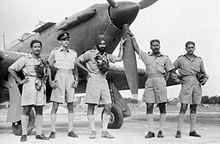
After it became independent from the British Empire in 1947, British India was partitioned into the new states of the Dominion of India and the Dominion of Pakistan. Along the lines of the geographical partition, the assets of the air force were divided between the new countries. India's air force retained the name of the Royal Indian Air Force, but three of the ten operational squadrons and facilities, located within the borders of Pakistan, were transferred to the Royal Pakistan Air Force. The RIAF Roundel was changed to an interim 'Chakra' roundel derived from the Ashoka Chakra.
Around the same time, conflict broke out between them over the control of the princely state of Jammu & Kashmir. With Pakistani forces moving into the state, its Maharaja decided to accede to India in order to receive military help. The day after, the Instrument of Accession was signed, the RIAF was called upon to transport troops into the war zone. And this was when a good management of logistics came into help. This led to the eruption of full-scale war between India and Pakistan, though there was no formal declaration of war. During the war, the RIAF did not engage the Pakistan Air Force in air-to-air combat; however, a couple of IAF Hawker Tempest fighters did intercept a Pakistani Douglas DC-3 transport aircraft & tried to shoot it down but the pilot of the DC-3 (Mukhtar Ahmad Dogar) managed to evade the fighters. Other than that, it also provided effective transport and close air support to the Indian troops.

When India became a republic in 1950, the prefix 'Royal' was dropped from the Indian Air Force. At the same time, the current IAF roundel was adopted.
Congo crisis and Annexation of Goa (1960–1961)
The IAF saw significant conflict in 1960, when Belgium's 75-year rule over Congo ended abruptly, engulfing the nation in widespread violence and rebellion. The IAF activated No. 5 Squadron, equipped with English Electric Canberra, to support the United Nations Operation in the Congo. The squadron started undertaking operational missions in November. The unit remained there until 1966, when the UN mission ended. Operating from Leopoldville and Kamina, the Canberras soon destroyed the rebel Air Force and provided the UN ground forces with its only long-range air support force.
In late 1961, the Indian government decided to attack the Portuguese colony of Goa after years of disagreement between New Delhi and Lisbon. The Indian Air Force was requested to provide support elements to the ground force in what was called Operation Vijay. Probing flights by some fighters and bombers were carried out from 8–18 December to draw out the Portuguese Air Force, but to no avail. On 18 December, two waves of Canberra bombers bombed the runway of Dabolim airfield taking care not to bomb the Terminals and the ATC tower. Two Portuguese transport aircraft (a Super Constellation and a DC-6) found on the airfield were left alone so that they could be captured intact. However the Portuguese pilots managed to take off the aircraft from the still damaged airfield and made their getaway to Portugal. Hunters attacked the wireless station at Bambolim. Vampires were used to provide air support to the ground forces. In Daman, Mystères were used to strike Portuguese gun positions. Ouragans (called Toofanis in the IAF) bombed the runways at Diu and destroyed the control tower, wireless station and the meteorological station. After the Portuguese surrendered the former colony was integrated into India.
Border disputes and changes in the IAF (1962–1971)
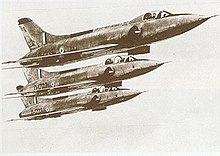
In 1962, border disagreements between China and India escalated to a war when China mobilised its troops across the Indian border. During the Sino-Indian War, India's military planners failed to deploy and effectively use the IAF against the invading Chinese forces. This resulted in India losing a significant amount of advantage to the Chinese; especially in Jammu and Kashmir.
On 24 April 1965, an Indian Ouragan strayed over the Pakistani border and was forced to land by a Pakistani Lockheed F-104 Starfighter, the pilot was returned to India; however, the captured aircraft would be kept by the Pakistan Air Force(PAF) and ended up being displayed at the PAF museum in Peshawar.
Three years after the Sino-Indian conflict, in 1965, Pakistan launched Operation Gibraltar, strategy of Pakistan to infiltrate Jammu and Kashmir, and start a rebellion against Indian rule. This came to be known as the Second Kashmir War. This was the first time the IAF actively engaged an enemy air force. However, instead of providing close air support to the Indian Army, the IAF carried out independent raids against PAF bases. These bases were situated deep inside Pakistani territory, making IAF fighters vulnerable to anti-aircraft fire. During the course of the conflict, the PAF enjoyed technological superiority over the IAF and had achieved substantial strategic and tactical advantage due to the suddenness of the attack and advanced state of their air force. The IAF was restrained by the government from retaliating to PAF attacks in the eastern sector while a substantive part of its combat force was deployed there and could not be transferred to the western sector, against the possibility of Chinese intervention. Moreover, international (UN) stipulations and norms did not permit military force to be introduced into the Indian state of J&K beyond what was agreed during the 1949 ceasefire. Despite this, the IAF was able to prevent the PAF from gaining air superiority over conflict zones. The small and nimble IAF Folland Gnats proved effective against the F-86 Sabres of the PAF earning it the nickname "Sabre Slayers". By the time the conflict had ended, the IAF lost 60–70 aircraft, while the PAF lost 43 aircraft. More than 60% of IAF's aircraft losses took place in ground attack missions to enemy ground-fire, since fighter-bomber aircraft would carry out repeated dive attacks on the same target. According to, Air Chief Marshal Arjan Singh of the Indian Air Force, despite having been qualitatively inferior, IAF achieved air superiority in three days in the 1965 War.
After the 1965 war, the IAF underwent a series of changes to improve its capabilities. In 1966, the Para Commandos regiment was created. To increase its logistics supply and rescue operations ability, the IAF inducted 72 HS 748s which were built by Hindustan Aeronautics Limited (HAL) under licence from Avro. India started to put more stress on indigenous manufacture of fighter aircraft. As a result, HAL HF-24 Marut, designed by the famed German aerospace engineer Kurt Tank, were inducted into the air force. HAL also started developing an improved version of the Folland Gnat, known as HAL Ajeet. At the same time, the IAF also started inducting Mach 2 capable Soviet MiG-21 and Sukhoi Su-7 fighters.
Bangladesh Liberation War (1971)
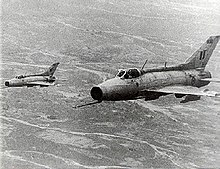
By late 1971, the intensification of the independence movement in East Pakistan lead to the Bangladesh Liberation War between India and Pakistan. On 22 November 1971, 10 days before the start of a full-scale war, four PAF F-86 Sabre jets attacked Indian and Mukti Bahini positions at Garibpur, near the international border. Two of the four PAF Sabres were shot down and one damaged by the IAF's Folland Gnats. On 3 December, India formally declared war against Pakistan following massive preemptive strikes by the PAF against Indian Air Force installations in Srinagar, Ambala, Sirsa, Halwara and Jodhpur. However, the IAF did not suffer significantly because the leadership had anticipated such a move and precautions were taken. The Indian Air Force was quick to respond to Pakistani air strikes, following which the PAF carried out mostly defensive sorties.
Within the first two weeks, the IAF had carried out almost 12,000 sorties over East Pakistan and also provided close air support to the advancing Indian Army. IAF also assisted the Indian Navy in its operations against the Pakistani Navy in the Bay of Bengal and Arabian Sea. On the western front, the IAF destroyed more than 20 Pakistani tanks, 4 APCs and a supply train during the Battle of Longewala. The IAF undertook strategic bombing of West Pakistan by carrying out raids on oil installations in Karachi, the Mangla Dam and a gas plant in Sindh. Similar strategy was also deployed in East Pakistan and as the IAF achieved complete air superiority on the eastern front, the ordnance factories, runways, and other vital areas of East Pakistan were severely damaged. By the time Pakistani forces surrendered, the IAF destroyed 94 PAF Aircraft The IAF was able to conduct a wide range of missions – troop support; air combat; deep penetration strikes; para-dropping behind enemy lines; feints to draw enemy fighters away from the actual target; bombing; and reconnaissance. In contrast, the Pakistan Air Force, which was solely focused on air combat, was blown out of the subcontinent's skies within the first week of the war. Those PAF aircraft that survived took refuge at Iranian air bases or in concrete bunkers, refusing to offer a fight. Hostilities officially ended at 14:30 GMT on 17 December, after the fall of Dacca on 15 December. India claimed large gains of territory in West Pakistan (although pre-war boundaries were recognised after the war), and the independence of Pakistan's East wing as Bangladesh was confirmed. The IAF had flown over 16,000 sorties on both East and West fronts; including sorties by transport aircraft and helicopters. while the PAF flew about 30 and 2,840. More than 80 per cent of the IAF's sorties were close-support and interdiction, and according to neutral assessments about 45 IAF Aircraft were lost while, Pakistan lost 75 aircraft. Not including any F-6s, Mirage IIIs, or the six Jordanian F-104s which failed to return to their donors. But the imbalance in air losses was explained by the IAF's considerably higher sortie rate, and its emphasis on ground-attack missions. On the ground Pakistan suffered most, with 9,000 killed and 25,000 wounded while India lost 3,000 dead and 12,000 wounded. The loss of armoured vehicles was similarly imbalanced. This represented a major defeat for Pakistan. Towards the end of the war, IAF's transport planes dropped leaflets over Dhaka urging the Pakistani forces to surrender, demoralising Pakistani troops in East Pakistan.
Incidents before Kargil (1984–1988)
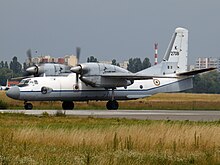
In 1984, India launched Operation Meghdoot to capture the Siachen Glacier in the contested Kashmir region. In Op Meghdoot, IAF's Mi-8, Chetak and Cheetah helicopters airlifted hundreds of Indian troops to Siachen. Launched on 13 April 1984, this military operation was unique because of Siachen's inhospitable terrain and climate. The military action was successful, given the fact that under a previous agreement, neither Pakistan nor India had stationed any personnel in the area. With India's successful Operation Meghdoot, it gained control of the Siachen Glacier. India has established control over all of the 70 kilometres (43 mi) long Siachen Glacier and all of its tributary glaciers, as well as the three main passes of the Saltoro Ridge immediately west of the glacier—Sia La, Bilafond La, and Gyong La. Pakistan controls the glacial valleys immediately west of the Saltoro Ridge. According to the TIME magazine, India gained more than 3,000 square kilometres (1,000 sq mi) of territory because of its military operations in Siachen.
Following the inability to negotiate an end to the Sri Lankan Civil War, and to provide humanitarian aid through an unarmed convoy of ships, the Indian Government decided to carry out an airdrop of the humanitarian supplies on the evening of 4 June 1987 designated Operation Poomalai (Tamil: Garland) or Eagle Mission 4. Five An-32s escorted by four Mirage 2000 of 7 Sqn AF, 'The Battleaxes', carried out the supply drop which faced no opposition from the Sri Lankan Armed Forces. Another Mirage 2000 orbited 150 km away, acting as an airborne relay of messages to the entire fleet since they would be outside radio range once they descended to low levels. The Mirage 2000 escort formation was led by Wg Cdr Ajit Bhavnani, with Sqn Ldrs Bakshi, NA Moitra and JS Panesar as his team members and Sqn Ldr KG Bewoor as the relay pilot. Sri Lanka accused India of "blatant violation of sovereignty". India insisted that it was acting only on humanitarian grounds.
In 1987, the IAF supported the Indian Peace Keeping Force (IPKF) in northern and eastern Sri Lanka in Operation Pawan. About 70,000 sorties were flown by the IAF's transport and helicopter force in support of nearly 100,000 troops and paramilitary forces without a single aircraft lost or mission aborted. IAF An-32s maintained a continuous air link between air bases in South India and Northern Sri Lanka transporting men, equipment, rations and evacuating casualties. Mi-8s supported the ground forces and also provided air transportation to the Sri Lankan civil administration during the elections. Mi-25s of No. 125 Helicopter Unit were utilised to provide suppressive fire against militant strong points and to interdict coastal and clandestine riverine traffic.
On the night of 3 November 1988, the Indian Air Force mounted special operations to airlift a parachute battalion group from Agra, non-stop over 2,000 kilometres (1,200 mi) to the remote Indian Ocean archipelago of the Maldives in response to Maldivian president Gayoom's request for military help against a mercenary invasion in Operation Cactus. The IL-76s of No. 44 Squadron landed at Hulhule at 0030 hours and the Indian paratroopers secured the airfield and restored Government rule at Male within hours. Four Mirage 2000 aircraft of 7 Sqn, led by Wg Cdr AV 'Doc' Vaidya, carried out a show of force early that morning, making low-level passes over the islands.
Kargil War (1999)
On 11 May 1999, the Indian Air Force was called in to provide close air support to the Indian Army at the height of the ongoing Kargil conflict with the use of helicopters. The IAF strike was code named Operation Safed Sagar. The first strikes were launched on 26 May, when the Indian Air Force struck infiltrator positions with fighter aircraft and helicopter gunships. The initial strikes saw MiG-27s carrying out offensive sorties, with MiG-21s and later MiG-29s providing fighter cover. The IAF also deployed its radars and the MiG-29 fighters in vast numbers to keep check on Pakistani military movements across the border. Srinagar Airport was at this time closed to civilian air-traffic and dedicated to the Indian Air Force.
On 27 May, the Indian Air Force suffered its first fatality when it lost a MiG-21 and a MiG-27 in quick succession. The following day, while on an offensive sortie, a Mi-17 was shot down by three Stinger missiles and lost its entire crew of four. Following these losses the IAF immediately withdrew helicopters from offensive roles as a measure against the threat of Man-portable air-defence systems (MANPAD). On 30 May, the Mirage 2000s were introduced in offensive capability, as they were deemed better in performance under the high-altitude conditions of the conflict zone. Mirage 2000s were not only better equipped to counter the MANPAD threat compared to the MiGs, but also gave IAF the ability to carry out aerial raids at night. The MiG-29s were used extensively to provide fighter escort to the Mirage 2000. Radar transmissions of Pakistani F-16s were picked up repeatedly, but these aircraft stayed away. The Mirages successfully targeted enemy camps and logistic bases in Kargil and severely disrupted their supply lines. Mirage 2000s were used for strikes on Muntho Dhalo and the heavily defended Tiger Hill and paved the way for their early recapture. At the height of the conflict, the IAF was conducting over forty sorties daily over the Kargil region. By 26 July, the Indian forces had successfully repulsed the Pakistani forces from Kargil.
Post Kargil incidents (1999–present)
Since the late 1990s, the Indian Air Force has been modernising its fleet to counter challenges in the new century. The fleet size of the IAF has decreased to 33 squadrons during this period because of the retirement of older aircraft. Still, India maintains the fourth largest air force in the world. The IAF plans to raise its strength to 42 squadrons. Self-reliance is the main aim that is being pursued by the defence research and manufacturing agencies.
On 10 August 1999, IAF MiG-21s intercepted a Pakistan Navy Breguet Atlantique which was flying over Sir Creek, a disputed territory. The aircraft was shot down killing all 16 Pakistani Navy personnel on board. India claimed that the Atlantic was on a mission to gather information on IAF air defence, a charge emphatically rejected by Pakistan which argued that the unarmed aircraft was on a training mission.
On 2 August 2002, the Indian Air Force bombed Pakistani posts along the Line of Control in the Kel sector, following inputs about Pakistani military buildup near the sector.
On 20 August 2013, the Indian Air Force created a world record by performing the highest landing of a C-130J at the Daulat Beg Oldi airstrip in Ladakh at the height of 5,065 metres (16,617 ft). The medium-lift aircraft will be used to deliver troops, supplies and improve communication networks. The aircraft belonged to the Veiled Vipers squadron based at Hindon Air Force Station.
On 13 July 2014, two MiG-21s were sent from Jodhpur Air Base to investigate a Turkish Airlines aircraft over Jaisalmer when it repeated an identification code, provided by another commercial passenger plane that had already entered Indian airspace before it. The flights were on their way to Mumbai and Delhi, and the planes were later allowed to proceed after their credentials were verified.
2019 Balakot airstrike
Following heightened tensions between India and Pakistan after the 2019 Pulwama attack that was carried out by Jaish-e-Mohammed (JeM) which killed forty servicemen of the Central Reserve Police Force, a group of twelve Mirage 2000 fighter planes from the Indian Air Force carried out air strikes on alleged JeM bases in Chakothi and Muzaffarabad in the Pakistan-administered Kashmir. Furthermore, the Mirage 2000s targeted an alleged JeM training camp in Balakot, a town in the Pakistani province of Khyber Pakhtunkhwa. Pakistan claimed that the Indian aircraft had only dropped bombs in the forest area demolishing pine trees near the Jaba village which is 19 kilometres (12 mi) away from Balakot and Indian officials claimed to bomb and kill a large number of terrorists in the airstrike.
2019 India–Pakistan standoff
On 27 February 2019, in retaliation for the IAF bombing of an alleged terrorist hideout in Balakot, a group of PAF Mirage-5 and JF-17 fighters allegedly conducted an airstrike against certain ground targets across the Line of Control. They were intercepted by a group of IAF fighters consisting of Su-30MKI and MiG-21 jets. An ensuing dogfight began. According to India, one PAF F-16 was shot down by an IAF MiG-21 piloted by Abhinandan Varthaman, while Pakistan denied use of F-16s in the operation. According to Pakistan, a MiG-21 and a Su30MKI were shot down, while India claims that only the MiG-21 was shot down. Indian officials rejected Pakistani claims of shooting down an Su-30MKI stating that it's impossible to hide an aircraft crash as of now in a populated area like Kashmir and said it's a coverup for the loss of F16. While the downed MiG-21's pilot had ejected successfully, he landed in Pakistan-administered Kashmir, and was captured by the Pakistan military. Before his capture he was assaulted by a few locals. After a couple of days of captivity, the captured pilot was released by Pakistan per Third Geneva convention obligations. While Pakistan denied involvement of any of its F-16 aircraft in the strike, the IAF presented remnants of AMRAAM missiles that are only carried by the F-16s within the PAF as proof of their involvement. Unnamed US officials told Foreign Policy magazine in April 2019 that an audit didn't find any Pakistani F-16s missing. However, this was not confirmed by the United States, which cited it as bilateral matter between US and Pakistan. Various international military observers reject Indian claim of shooting down PAF F-16.
IAF also lost a MI-17 helicopter during Indo-Pakistan standoff 2019. On the same day of 27 February 2019, around twenty minutes before the MiG-21 downing, an Indian Mil Mi-17 helicopter crashed, killing six Indian Air Force personnel and one civilian in the Budgam district. It was under the command of squadron leaders Siddarth Vashista and Ninad Mandavgane and crashed within ten minutes of take-off from the Srinagar air base. Four other IAF personnel were flight engineer Vishal Kumar Pandey, sergeant Vikrant Sehrawat, corporals Deepak Pandey and Pankaj Kumars that were killed along with two pilots. In October 2019, IAF confirmed that the helicopter was shot down by an Indian SPYDER surface-to-air missile mistaking it as an PAF aircraft and said that five personnel were held guilty for the lapses. IAF dismissed Group Captain Suman Roy Choudhry Chief Operations Officer (COO) of the Srinagar Air Force Station from his service in 2023 for his negligence during PAF strikes.
Structure
The President of India is the Supreme Commander of all Indian armed forces and by virtue of that fact is the national Commander-in-chief of the Air Force. The Chief of the Air Staff with the rank of Air chief marshal is the Commander
| Post | Current Holder |
|---|---|
| Chief of the Air Staff | Air Chief Marshal Amar Preet Singh, PVSM, AVSM |
| Vice Chief of the Air Staff | Air Marshal Sujeet Pushpakar Dharkar, PVSM, AVSM |
| Deputy Chief of the Air Staff | Air Marshal Tejinder Singh. AVSM, VM |
| Air Officer in Charge of Administration | Air Marshal Rajesh Kumar Anand, VSM |
| Air Officer in Charge of Personnel | Air Marshal Sunil Kashinath Vidhate, AVSM, VM |
| Air Officer in Charge of Maintenance | Air Marshal Vijay Kumar Garg, AVSM, VSM |
| Director General of Air Operations | Air Marshal Surat Singh, AVSM, VM, VSM |
| Director General of Inspection and Flight Safety | Air Marshal Markand Ranade, AVSM, VM |
| Director General of Medical Services (Air) | Air Marshal Prashant Bharadwaj, AVSM, VSM & Bar, |
In January 2002, the government conferred the rank of Marshal of the Indian Air Force on Arjan Singh making him the first and only Five-star officer with the Indian Air Force and ceremonial chief of the air force.
Commands
The Indian Air Force is divided into five operational and two functional commands. Each Command is headed by an Air Officer Commanding-in-Chief with the rank of Air Marshal. The purpose of an operational command is to conduct military operations using aircraft within its area of responsibility, whereas the responsibility of functional commands is to maintain combat readiness. Aside from the Training Command at Bangalore, the primary flight training is done at the Air Force Academy (located in Hyderabad), followed by operational training at various other schools. Advanced officer training for command positions is also conducted at the Defence Services Staff College; specialised advanced flight training schools are located at Bidar, Karnataka and Hakimpet, Telangana (also the location for helicopter training). Technical schools are found at a number of other locations.
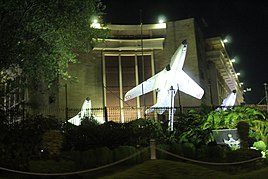
| Name | Headquarters | Commander |
|---|---|---|
| Central Air Command (CAC) | Prayagraj, Uttar Pradesh | Air Marshal Ashutosh Dixit, AVSM, VM, VSM |
| Eastern Air Command (EAC) | Shillong, Meghalaya | Air Marshal Surat Singh, AVSM, VM, VSM |
| Southern Air Command (SAC) | Thiruvananthapuram, Kerala | Air Marshal Balakrishnan Manikantan, AVSM, VM |
| South Western Air Command (SWAC) | Gandhinagar, Gujarat | Air Marshal Narmdeshwar Tiwari, AVSM, VM |
| Western Air Command (WAC) | New Delhi | Air Marshal Pankaj Mohan Sinha, PVSM, AVSM, VSM |
| Training Command (TC)+ | Bangalore, Karnataka | Air Marshal Nagesh Kapoor, AVSM, VM |
| Maintenance Command (MC)+ | Nagpur, Maharashtra | Air Marshal Vijay Kumar Garg, AVSM, VSM |
Note: + = Functional Command
Wings
A wing is a formation intermediate between a command and a squadron. It generally consists of two or three IAF squadrons and helicopter units, along with forward base support units (FBSU). FBSUs do not have or host any squadrons or helicopter units but act as transit airbases for routine operations. In times of war, they can become fully fledged air bases playing host to various squadrons. In all, about 47 wings and 19 FBSUs make up the IAF. Wings are typically commanded by an air commodore.
Stations
Within each operational command are anywhere from nine to sixteen bases or stations. Smaller than wings, but similarly organised, stations are static units commanded by a group captain. A station typically has one wing and one or two squadrons assigned to it.
Squadrons and units
Squadrons are the field units and formations attached to static locations. Thus, a flying squadron or unit is a sub-unit of an air force station which carries out the primary task of the IAF. A fighter squadron consists of 18 aircraft; all fighter squadrons are headed by a commanding officer with the rank of wing commander. Some transport squadrons and helicopter units are headed by a commanding officer with the rank of group captain.
Flights
Flights are sub-divisions of squadrons, commanded by a squadron leader. Each flight consists of two sections.
Sections
The smallest unit is the section, led by a flight lieutenant. Each section consists of three aircraft.
Within this formation structure, IAF has several service branches for day-to-day operations. They are:
Flying Branch
|
Technical Branch
|
Ground Branch
|
Garud Commando Force
The Garud commandos are the special forces of the Indian Air Force (IAF). Their tasks include counter-terrorism, hostage rescue, providing security to IAF's vulnerably located assets and various air force-specific special operations. First conceived in 2002, this unit was officially established on February 6, 2004.


All Garuds are volunteers who are imparted a 52-week basic training, which includes a three-month probation followed by special operations training, basic airborne training and other warfare and survival skills. The last phase of basic training sees Garuds been deployed to get combat experience. Advanced training follows, which includes specialised weapons training.
The mandated tasks of the Garuds include direct action, special reconnaissance, rescuing downed pilots in hostile territory, establishing airbases in hostile territory and providing air-traffic control to these airbases. The Garuds also undertake suppression of enemy air defences and the destruction of other enemy assets such as radars, evaluation of the outcomes of Indian airstrikes and use laser designators to guide Indian airstrikes.
The security of IAF installations and assets are usually performed by the Air Force Police and the Defence Security Corps even though some critical assets are protected by the Garuds.
Defence Space Agency

The Defence Space Agency, an integrated tri-services agency, which draws its personnel from all the three services of the Indian armed forces, is set up to operate the space-warfare and Satellite Intelligence assets of India.
Unlike an aerospace command, where the air force controls most of its activities, the Defence Space Agency envisages co-operation and co-ordination between the three services as well as civilian agencies dealing with space.
India currently has 10 military satellites.
Display teams
